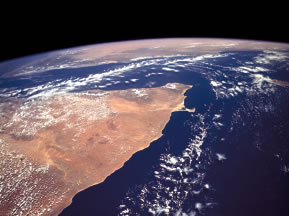This is a drawing of seafloor spreading.
Click on image for full size
Image copyright 1997 by the American Geophysical Union. Further electronic distribution is not allowed.
Mid-Ocean Spreading Ridge
As the Earth cools, hot material from the deep interior rises to the surface. Hot material is depicted in red in this drawing, under an ocean shown in blue green.
The hotter material elevates the nearby layers, and the cooler, denser lithosphere (in yellow in the drawing) slides away from the elevated region. The drawing shows that the cool crust slides at a rate of about 4 cm per year. The elevated region where new material is coming forth is called a "spreading ridge". Most of the spreading ridges of today are to be found in the central portion of the world's oceans.
The large version of this drawing shows a spreading ridge at the left and a slab of lithosphere being subducted at the bottom right. Near the subducting slab, remelting, and volcano formation are taking place. The trench associated with subduction can also be seen in the large version of this drawing.
You might also be interested in:

When two sections of the Earth's lithosphere collide one slab of lithosphere can be forced back down into the deeper regions of the Earth, as shown in this diagram. This process is called subduction.
...more
Volcanoes form when hot material from below risesand leaks into the crust. This hot material, called magma, comes either from a melt of subducted crustal material, which is light and buoyant after melting,
...more
Basalt is a hard, black extrusive igneous rock. It is the most common type of rock in the Earth's crust and it makes up most of the ocean floor. The prevalence of dark minerals such as pyroxene and olivine
...more
Hello again, from 9°50'N in the east Pacific Ocean (also known at the East Pacific Rise or EPR)! Did you know that deep beneath the surface of the ocean lies a mountain chain that stretches around the
...more
Earth is continuously changing. Big Idea 4.1 Earth’s geosphere changes through geological, hydrological, physical, chemical, and biological processes that are explained by universal laws. These changes
...more
The Earth has one big ocean with many features. Fundamental Concept 1a. The ocean is the dominant physical feature on our planet Earth—covering approximately 70% of the planet’s surface. There is one ocean
...more
Ash is made of millions of tiny fragments of rock and glass formed during a volcanic eruption. Volcanic ash particles are less than 2 mm in size and can be much smaller. Volcanic ash forms in several ways
...more















